A dream vacation is made in part by those smooth sheets on the tightly made hotel bed. The International Executive Housekeepers Association demystifies the tidy skill of professional bed making so you can bring that clean, cozy atmosphere home. You may be surprised to learn the entire technique takes less than three minutes with practice.
Begin with a freshly laundered sheet set. Place all bedding on a nearby chair to prevent contact with the floor. While many hotels use flat sheets for both top and bottom — securing the lower sheet by the miracle of hospital corners — you probably own a perfectly beautiful, fitted bottom sheet. Pull it taut from corner to corner until the mattress is covered.
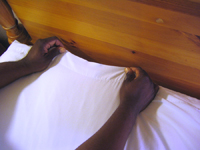
Standing at the footboard, shake out the top sheet until it billows down evenly over the bed; adjust to ensure a similar length drapes down either side of the mattress. Moving to the head of the bed, lift the end of the sheet and lay the hem in one smooth line directly along the headboard. Returning to the foot of the bed, gently pull out any bunching until the sheet lies flat and the excess dangles toward your feet.
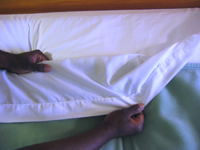
Repeat this step with your blanket of choice, but lay the top hem two hand widths short of the headboard. Fold the top sheet back over the blanket to protect the sleeper’s face from rough fabric — and to protect the blanket from body oils and moisture that increase the need for laundering. Give the top sheet and blanket two swift hospital corners (see below) at the foot, leaving the sides loose to ease tucking yourself in.
Hospital Corners
This tidy trick sounds complicated but takes only seconds to apply. Tuck the top sheet and blanket together under the foot of the mattress. When you are done, the dangling fabric at the sides of the foot will have made a short U-turn back along the length of the bed. Pinch the U between your fingers and pull it toward the headboard, parallel to the mattress. Then, tuck the hanging corners of the sheet and blanket together under the mattress. Let the remaining fabric fall over the tucked portion, and that, as they say, is that.

Finishing Touches
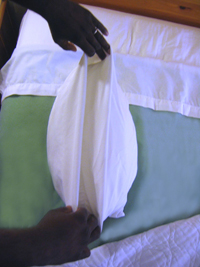
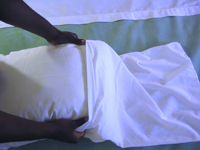 To save your pillows from oils, etc., avoid grasping them under the chin to pull on the cases. Instead, lay them on the bed and inch the cases on with rocking hand motions. A vertical shaking should take care of the rest. If the length of the case overwhelms the pillow, tuck the top surface over the end and just inside the bottom fabric. Fold the bottom excess in after it to form a smooth pocket — as if the pillow's lips were inside out (or, rather, outside in). Set the pillows aside for a moment.
To save your pillows from oils, etc., avoid grasping them under the chin to pull on the cases. Instead, lay them on the bed and inch the cases on with rocking hand motions. A vertical shaking should take care of the rest. If the length of the case overwhelms the pillow, tuck the top surface over the end and just inside the bottom fabric. Fold the bottom excess in after it to form a smooth pocket — as if the pillow's lips were inside out (or, rather, outside in). Set the pillows aside for a moment.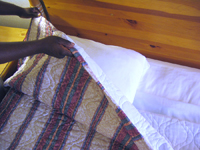
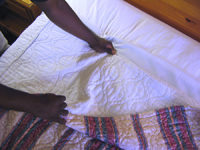 Apply the bedspread, keeping the length even along the sides and foot of the bed. You should have significant surplus at the headboard. Double this back over the spread until the fold line runs parallel to the headboard a few inches short of the top sheet. Center the sleeping pillows on the fold and lift the remaining spread over their tops. This prevents the day’s dust fall from resting on the pillows.
Apply the bedspread, keeping the length even along the sides and foot of the bed. You should have significant surplus at the headboard. Double this back over the spread until the fold line runs parallel to the headboard a few inches short of the top sheet. Center the sleeping pillows on the fold and lift the remaining spread over their tops. This prevents the day’s dust fall from resting on the pillows.
Alternate ending: Use a bed skirt and choose a coordinating comforter in place of the blanket.
Toss decorative pillows and throws as desired. Mints are optional.
[Editor's Note: In some upscale hotels, the bedspread is being replaced by triple sheeting, featuring a decorative top sheet. Comforters or blankets fit between the triple sheeting. Linens are laundered daily, reducing the need to wash comforters or blankets as often, and making the bedding more hygienic and welcoming. If you are interested in more information about using triple sheeting at home, email Beth Risinger, Executive Director of IEHA, brisinger@ieha.org.]










